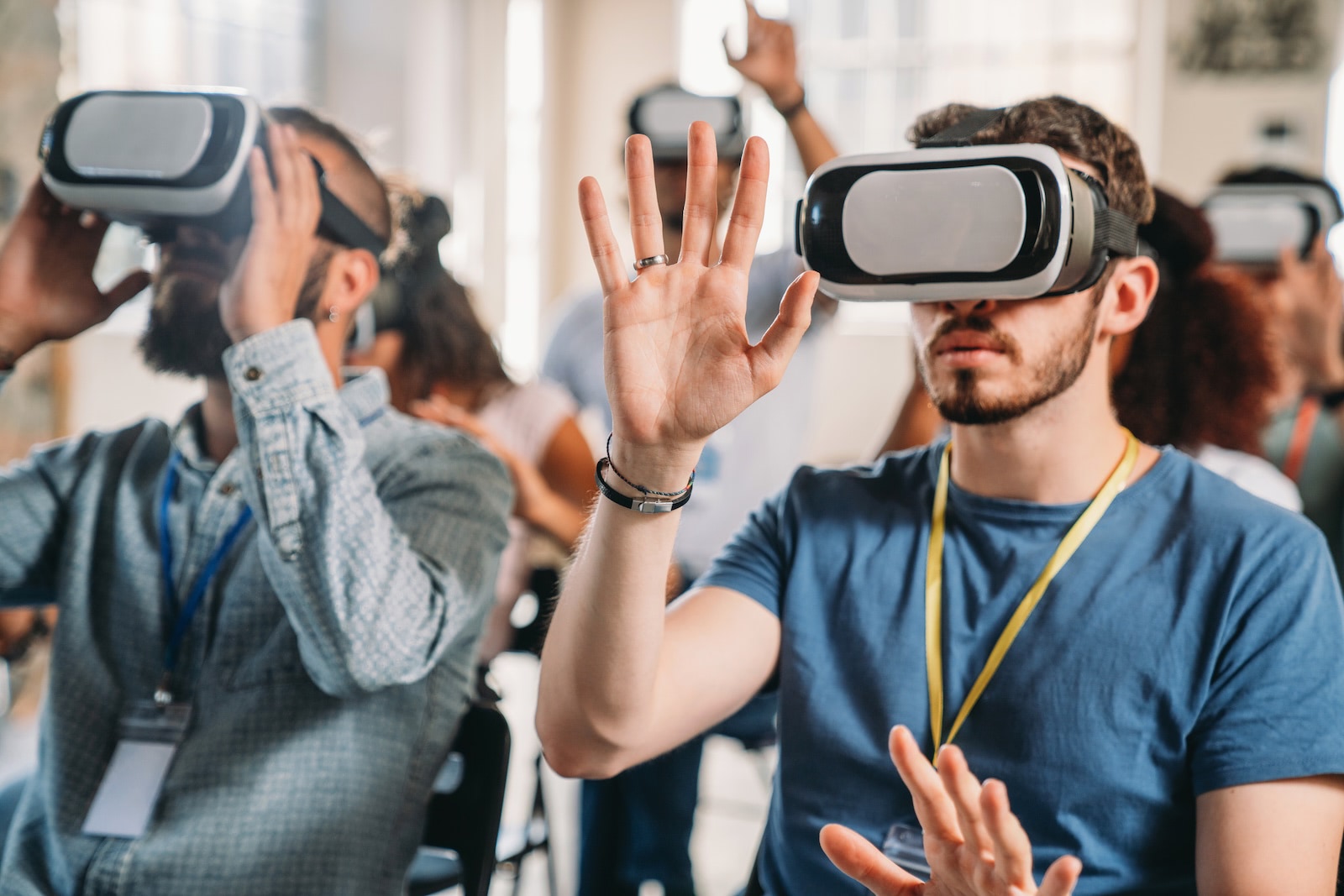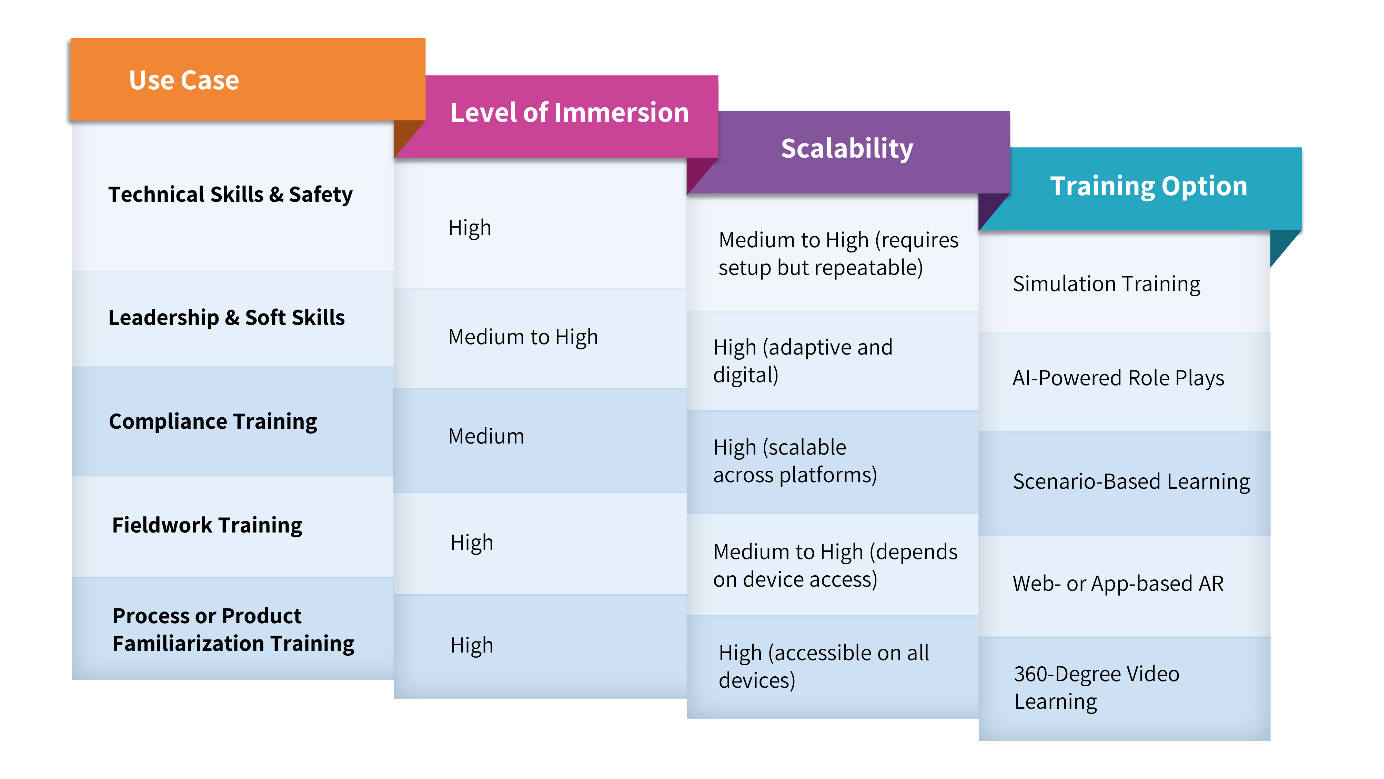
Introduction
Traditional learning methods are losing effectiveness as today’s workforce—especially digital-native employees—demands experiential, tech-driven learning. Organizations are recognizing the power of immersive learning to enhance knowledge retention, build critical skills, and improve learner engagement. But does immersive learning require expensive VR headsets and wearables to scale? The answer is no.
With advancements in AI, spatial computing, and cloud-based solutions, immersive learning is moving beyond hardware-dependent approaches, making it more accessible, cost-effective, and scalable than ever before.
The shift is clear: web-based XR and realistic AI-powered simulations are unlocking immersive experiences without the burden of specialized hardware. As organizations seek to train global, hybrid, and deskless workforces, adopting scalable alternatives to traditional VR-based training is becoming a strategic necessity.
The Challenge of Scaling Immersive Learning with Wearables
It is reported that learners trained in a VR environment develop soft skills 4X faster than learners trained in the classroom.
- 40% learners are more confident in applying what they’ve learned
- 83% of the surgeons trained in VR were ready to perform procedures with little guidance after training as against 0% using traditional methods
- Retention rates soar to 80% a year later for VR-trained medical staff—versus 20% one week later using conventional training.
Despite these benefits, scaling immersive learning with wearables remains a challenge due to several key barriers:
- Cost Barriers: Organizations are required to make heavy investments in hardware, thereby adversely impacting widespread adoption. In addition to the high cost of VR headsets, software licensing fees and ongoing maintenance, can create a significant financial hurdle in scaling immersive learning, especially in budget-constrained environments. Furthermore, frequent updates and compatibility issues can add to long-term costs. As a result, a handful of organizations including those that either have smaller audiences with their own VR headsets or larger enterprises that are early adopters, are able to scale immersive learning.
- Access & Scalability Issues: Another major challenge is limited access to VR devices, particularly for remote learners and deskless workers. Providing costly headsets to selective learners can create disparities in training opportunities. Logistical challenges such as device distribution, maintenance, and internet connectivity can further hinder adoption.
- LMS & System Integration Challenges: Integrating VR learning experiences with existing Learning Management Systems (LMS) can be complex, especially when dealing with rigid LMS solutions that lack flexibility. While integration is possible with careful planning, many organizations face challenges in ensuring seamless data flow between VR-based learning and their broader training ecosystems. Additionally, some VR solutions operate in standalone environments, making it more time-consuming to track learner progress, manage content, and sync data efficiently. This can lead to inefficiencies and increased costs when adapting immersive learning into traditional L&D frameworks.
- Workforce-based Hurdles: Some learners find VR-based training complex, intimidating, or physically uncomfortable. In addition to accessibility barriers caused by technical requirements, such as device setup, software updates, and connectivity issues, learners may struggle with navigation, controls, or motion sickness. These impediments can cause frustration and reduce learner engagement.
The Solution: Moving Beyond Hardware Dependency
Organizations looking to scale immersive learning need a framework to select the right technologies—ensuring balance between cost, accessibility, and effectiveness.
Framework for Determining Type of Immersive Learning
Creating a framework that helps determine the most effective technology—VR, AR, MR, or AI-driven simulations—can allow organizations to ensure that immersive experiences align with learning goals while also balancing cost, accessibility, and integration with existing systems.
- Use Case: To identify the specific training requirement or scenario where immersive learning can add maximum value, justify investment, and measure the effectiveness of immersive learning solutions, consider factors such as skill complexity, learner environment, and desired outcomes to determine the most appropriate immersive technologies. For instance, realistic simulations for hands-on practice may be more appropriate for high-risk industries like healthcare and manufacturing, whereas AI-driven virtual interactions may be used for soft skills training.
- Level of Immersion: To assess how deeply a learner is engaged within the training environment, ranging from basic 3D interactions to fully immersive VR simulations, consider factors like learning objectives, cognitive load, and accessibility to select the appropriate level of immersion and ensure the right balance between engagement and practicality.
- Scalability: To evaluate the ease of expanding immersive learning to larger audiences without requiring customization or adding to the costs, consider factors like device compatibility, content adaptability, and ease of deployment to ascertain whether a solution can be efficiently scaled. For instance, AI-driven simulations or AR on mobile devices offer greater scalability compared to hardware-dependent VR experiences. Although highly customized or hardware-intensive solutions provide deep engagement, they can be costly and difficult to implement across diverse learner groups.
- Optimal Alternative: The best solution depends on use case, immersion needs, and scalability requirements. By selecting adaptable, device-agnostic solutions, organizations can ensure both effectiveness and ease of implementation at scale, while also reaching a wider audience without adding significant costs or logistical challenges. For instance, AI-powered virtual role-play or browser-based interactive scenarios can be used for soft skills training instead of headset-based VR experiences.
Scalable Alternatives to Gear/Wearable Dependent Immersive Learning
Scalable immersive learning need not be gear-dependent. Leveraging scalable alternatives, as described below, organizations can enhance accessibility while reducing reliance on expensive hardware.
- Simulation Training: Uses AI-driven or cloud-based virtual environments to replicate real-world scenarios without the need for specialized gear, enabling organizations to scale immersive learning efficiently. It offers broader accessibility and easily integrates with existing learning platforms. With the ability to adapt to learner performance, simulation training not only provides learners with a controlled, risk-free setting to practice skills, but also offers personalized feedback and dynamic learning experiences.
- Scenario-Based Learning: Provides learners with a guided, interactive environment that immerses learners in real-world situations where they must make decisions and solve problems. Uses AI-driven chatbots, mobile-based AR, or cloud-powered simulations, to deliver personalized scenarios based on learner responses, enhancing learner engagement and retention. Unlike VR-dependent training, scenario-based learning is accessible through standard devices, which reduces costs and logistical barriers and makes them highly scalable and accessible.
- AI-Powered Role-Plays: Ideal for soft skills training, leadership development, and customer service simulations, AI-powered role plays simulate real-life scenarios allowing learners to practice interpersonal and problem-solving skills in a dynamic environment. They eliminate the need for VR headsets and specialized hardware by delivering these scenarios through web-based platforms or mobile devices, making it cost-effective for large audiences. Further, by adapting to learner responses and providing real-time feedback, they personalize learning paths for improved engagement.
- Web- or App-based Augmented Reality (AR): Leverages web-based or mobile AR solutions to make AR experiences more accessible and scalable. Allows learners to interact with digital overlays, guided instructions, or real-time simulations in their existing environment, enhancing hands-on learning. By eliminating the need for expensive hardware, these AR experiences enable cost-effective, scalable, flexible, and location-agnostic training.
- Immersive 360-Degree Learning: Allows learners to explore real-world spaces & processes in immersive environments on standard devices, without VR headsets. Learners can navigate scenarios, solve problems, and make decisions in a controlled virtual setting. Because delivery is cloud-based, these solutions are accessible on desktops, tablets, and smartphones, making them highly scalable and cost-effective.
Conclusion
Moving beyond learning solutions that depend on wearables and external gears can help organizations unlock new opportunities for immersive learning. To scale immersive learning, enhance accessibility and improve engagement beyond VR headsets and wearables, organizations can consider alternative solutions that are innovative yet cost-effective.
With rapid advancements in technology, organizations must prioritize flexibility, accessibility, and seamless integration to maximize the impact of their immersive learning initiatives.
AI-powered simulations, scenario-based learning, web-based AR, and interactive 360-degree video, provide immersive experiences without adding to the financial and logistical burdens of dedicated hardware. These scalable immersive learning alternatives integrate easily with existing learning systems, thereby ensuring broader reach and long-term sustainability.




